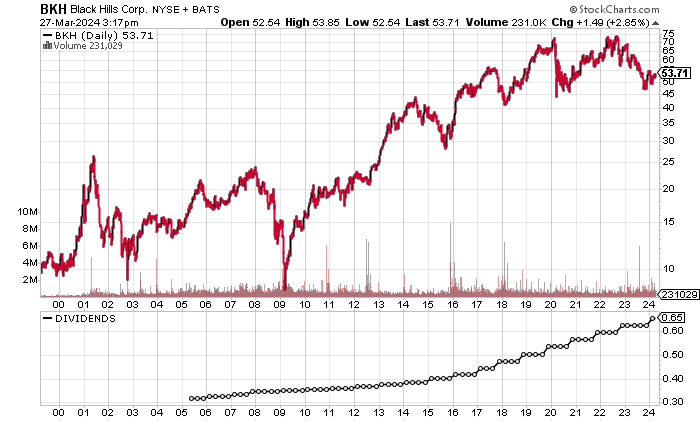Black Hills Stock a Dividend Aristocrat That Yields 5%

53 Years of Rising Dividends From BKH Stock
Receiving regular dividends is the prime objective of income investors. Better yet is receiving dividends from companies that consistently raise their payouts in good times and bad.
That’s what we have with Black Hills Corp (NYSE:BKH), a mid-cap, growth-driven utility company.
Black Hills serves about 1.3 million natural gas and electric utility customers across eight states: Arkansas, Colorado, Iowa, Kansas, Montana, Nebraska, South Dakota, and Wyoming. (Source: “Investor Relations,” Black Hills Corp, last accessed March 27, 2024.)
Income investors will love the dividend quality of Black Hills stock. The company has raised its dividends for 53 consecutive years. That makes Black Hills a dividend king and, since it’s included in the S&P 500, a dividend aristocrat.
As an income investor, you can’t get better than this. Moreover, the situation for capital-intensive utility companies should improve as interest rates begin to move lower by midyear and continue moving lower in 2025.
Black Hills Corp doesn’t have significant share-price appreciation potential, but the theme here is regular and growing dividends. BKH stock is ideal for income investors who require access to steady and higher dividends.
As of this writing, Black Hills stock has a yield of 4.98%. The company’s dividend coverage ratio is strong, at 5.6. Its payout ratio of 63.9% is higher than what I like to see, but it’s reasonable.
| Metric | Value |
| Dividend Growth Streak | 53 Years |
| Dividend Streak | 54 Years |
| 7-Year Dividend Compound Annual Growth Rate | 5.8% |
| 10-Year Average Dividend Yield | 3.6% |
| Dividend Coverage Ratio | 5.6 |
As interest rates decline, Black Hills Corp should be able to expand its margins. This could provide upside in terms of share price, given that, as of March 27, BKH stock was down by 19.8% from its 52-week high and down by 38.4% from its record high of $87.12 in February 2020.

Chart courtesy of StockCharts.com
Steady Revenues & Profitability
Black Hills Corp’s revenues have declined in three of the last five years, but they’ve grown by 34.4% from 2019 to 2023. The last two years saw Black Hills generate record-high revenues.
Analysts estimate that the company will have slightly lower revenue growth of 1.4% to $2.36 billion in 2024, followed by growth of 3.1% to $2.44 billion in 2025. (Source: “Black Hills Corporation (BKH),” Yahoo! Finance, last accessed March 27, 2024.)
| Fiscal Year | Revenues (Billions) | Growth |
| 2019 | $1.73 | N/A |
| 2020 | $1.70 | -2.2% |
| 2021 | $1.95 | 14.9% |
| 2022 | $2.55 | 30.9% |
| 2023 | $2.33 | -8.6% |
(Source: “Black Hills Corp.” MarketWatch, last accessed March 27, 2024.)
Black Hills Corp consistently generates 30%-plus gross margins, including renewed expansion in 2023. Lower interest rates should further drive the company’s margin expansion.
| Fiscal Year | Gross Margin |
| 2019 | 38.5% |
| 2020 | 41.8% |
| 2021 | 36.2% |
| 2022 | 30.3% |
| 2023 | 34.2% |
On the bottom line, Black Hills Corp has consistently generated generally accepted accounting principles (GAAP) profits, with growth in three of the last five years. While its GAAP-diluted earnings per share (EPS) fell slightly in 2023, it was the company’s third-highest GAAP-diluted EPS in 10 years.
Analysts expect the company to report a slight decline in earnings to $3.89 per diluted share in 2024, prior to improving to a record-high $4.11 per diluted share in 2025. (Source: Yahoo! Finance, op. cit.)
| Fiscal Year | GAAP-Diluted EPS | Growth |
| 2019 | $3.28 | -31.4% |
| 2020 | $3.65 | 11.2% |
| 2021 | $3.74 | 2.5% |
| 2022 | $3.97 | 6.1% |
| 2023 | $3.91 | -1.5% |
(Source: MarketWatch, op. cit.)
A look at Black Hills Corp’s free cash flow (FCF) shows negative results from 2019 through 2022, prior to showing a strong push to positive results in 2023.
A continuance of positive FCF would support the company’s dividends, capital expenditures, and paydown of its debt.
| Fiscal Year | FCF (Millions) | Growth |
| 2019 | -$312.9 | N/A |
| 2020 | -$225.5 | 27.9% |
| 2021 | -$742.1 | -229.0% |
| 2022 | -$19.6 | 97.4% |
| 2023 | $388.8 | 2,087% |
(Source: MarketWatch, op. cit.)
Black Hills Corp held $4.4 billion in total debt and $93.0 million in cash at the end of 2023. (Source: Yahoo! Finance, op. cit.)
I expect the company to pare down its debt, especially if its FCF continues to be positive. The lower interest rate environment will help reduce its interest obligations on expiring debt.
Black Hills Corp has managed to easily cover its annual interest expenses with higher earnings before interest and taxes (EBIT). The company’s interest coverage ratio of 2.7 in 2023 was healthy.
| Fiscal Year | EBIT (Millions) | Interest Expense (Millions) |
| 2020 | $420.6 | $144.9 |
| 2021 | $412.5 | $154.1 |
| 2022 | $458.6 | $162.6 |
| 2023 | $481.6 | $180.0 |
(Source: Yahoo! Finance, op. cit.)
Black Hills Corp’s Piotroski score—an indicator of a company’s balance sheet, profitability, and operational efficiency—is a reasonable reading of 6.0, which is above the midpoint of the Piotroski score’s range of 1.0 to 9.0.
The Lowdown on Black Hills Corp
Black Hills stock is an ideal complement for the portfolio of an income investor who requires regular and growing dividends and has less focus on share-price appreciation.
It’s always a good thing when institutional investors are behind a stock. In the case of Black Hills stock, 466 institutions hold an 88.7% stake (as of this writing). The two top institutional holders of BKH stock are BlackRock Inc (NYSE:BLK), with a 14.82% stake, and The Vanguard Group, Inc., with an 11.93% stake. (Source: Yahoo! Finance, op. cit.)











